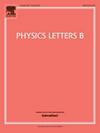Dark matter: Red or blue?
IF 4.5
2区 物理与天体物理
Q1 ASTRONOMY & ASTROPHYSICS
引用次数: 0
Abstract
We report the first calculation of light scattering on heavy dark matter (DM) particles. We show that despite the fact that DM has no direct coupling to photons, the light-DM() ( TeV) cross-section is non-vanishing, albeit small. The cross section, calculated within the Standard Model (SM) framework (no BSM extensions),is particularly large in the case of heavy Weakly Interacting Massive Particles (WIMP). Combined with astrophysical observation, these results can constrain existing WIMP DM models in favor of lighter DM, , (axions, composite DM, etc.) or non-weakly interacting pure gravitational DM. We also show that the energy dependence of light scattering on dark matter should make the DM colored - red in the case of weak-DM and blue for the gravitational-DM, when a white background light is passing through. Gravitational scattering of light on DM particles also leads to non-trivial polarization effects, which might be easier to detect than the deflection of light from the scattering on DM particles, .
暗物质:红色还是蓝色?
我们报道了重暗物质(DM)粒子上光散射的首次计算。我们表明,尽管DM与光子没有直接耦合,但光-DM(γχ) (mχ ~ 1 TeV)截面虽然很小,但不会消失。在标准模型(SM)框架内(没有BSM扩展)计算的横截面在重的弱相互作用大质量粒子(WIMP)的情况下特别大。结合天体物理观测,这些结果可以约束现有的WIMP DM模型,支持较轻的DM、mx<;<MPlanck、(轴子、复合DM等)或非弱相互作用的纯引力DM。我们还表明,当白色背景光通过时,光散射对暗物质的能量依赖应该使弱DM的DM呈红色,引力DM呈蓝色。光在DM粒子上的引力散射也会导致非平凡的极化效应,这可能比光在DM粒子上的散射引起的偏转更容易检测,γχ→γχ。
本文章由计算机程序翻译,如有差异,请以英文原文为准。
求助全文
约1分钟内获得全文
求助全文
来源期刊

Physics Letters B
物理-物理:综合
CiteScore
9.10
自引率
6.80%
发文量
647
审稿时长
3 months
期刊介绍:
Physics Letters B ensures the rapid publication of important new results in particle physics, nuclear physics and cosmology. Specialized editors are responsible for contributions in experimental nuclear physics, theoretical nuclear physics, experimental high-energy physics, theoretical high-energy physics, and astrophysics.
 求助内容:
求助内容: 应助结果提醒方式:
应助结果提醒方式:


